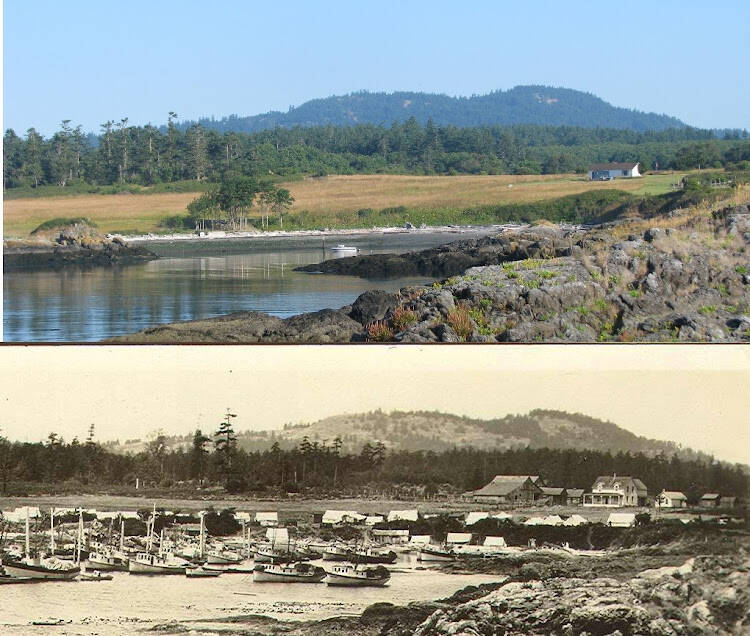For thousands of years, Garry oaks, Quercus garryana, dug their roots deep into craggy rocks and hilltops promoting a rich and diverse habitat. The savannahs where oaks thrive have dwindled to a fraction of what they once were. April 27 the Washington State University Extension Agency held an online presentation about the importance of oaks historically, and how citizens can become involved.
“Oaks provide structure, allowing understory plants to flourish, adding a biodiversity of wildflowers, which provide habitat for pollinators, birds, mammals, reptiles and on and on,” Doug McCutchen, Land Steward of the San Juan County Conservation Landbank said. Explorers and settlers alike were amazed at the rich ecosystem. McCutchen quoted Douglas James, of the Hudson Bay company who is recorded as saying in 1843 “the growth of the indigenous vegetation is more luxurious than anywhere else.”
According to San Juan County Conservation District forest health manager Kai Hoffman-Krull, Garry Oak ecosystems were highly cultivated and highly managed by the Native Americans who lived on the islands.
Small low density controlled fires not only helped keep the fast-growing Douglas Firs from crowding out oaks but enhanced the soil through the charcoal left behind. Jet black carbon-rich soil can still be found on Sandy Point, on Waldron Island, as a result of fires, for example. Sandy Point is an area where one would expect to find nutrient-poor sandy loam, according to Hoffman-Krull.
That potent soil feeds camas bulbs which were a staple in the local tribes’ diet.
Forest fires of the past, according to Hoffman-Krull, were not the high-temperature all-consuming fires of today, in part because forests, in general, were more diverse, and trees of varying ages. Due to clear-cuts and other human activity, a significant portion of woodland is second growth, smaller trees of the same species growing densely together. Ironically, fire prevention efforts have played a contributing role. According to Hoffman-Krull, approximately 85,000 acres in San Juan County are considered to be in moderate or severe fire danger.
“Imagine if we decided we didn’t like tides so we did away with them,” McCutchen said, noting what effects that would have on intertidal zones. “Removing fire has a similar impact.”
Without fire to keep them in check, Douglas Firs have outcompeted Garry oaks, taking over savannahs and blocking the sunlight oaks need.
“We have one of the oldest known Garry oaks in the world, on little old San Juan Island,” McCutchen said. The trees usually live approximately 350 years. When this old Quercus garryana was discovered, it was deep in the midst of the firs, stressed and struggling. With the help of oak restoration volunteers, the noble tree is regaining its health.
Endangered species associated with savannas and oaks are returning as well. Golden paintbrush is responding well to restoration efforts, according to McCutchen, and the San Juan Preservation’s Western Bluebird reintroduction project is also doing well.
“Six different Land bank preservation sites have active Garry oak restoration,” McCutchen said.
“Indigenous knowledge could bridge the missing puzzle,” he said.
Hoffman-Krull added that a bold move might be co-managing public lands with the tribes. He cited the Treaty of Point Elliot from 1855 and the Bolt decision of 1974 to back up the idea.
“The treaty of Pt. Elliot allowed tribes to continue gathering roots, berries, and other activities on open and unclaimed lands,” Hoffman-Krull said. The Bolt decision is known for its language regarding fishing, however, it also reaffirmed tribal rights in regard to natural resources.
“How radical would it be if the Garry oak public lands were co-managed with the tribes?” Hoffman-Krull asked.
Meanwhile, the Islands Conservation Corps is stepping in to assist with restoration projects as well. The ICC offers an Ecological Restoration Certificate in the San Juan Islands in partnership with Huxley College of the Environment at Western Washington University, according to the district’s website. The program combines academic coursework and hands-on implementation of the fundamentals of ecological restoration, preparing the next generation of ecologists for the Pacific Northwest land management workforce. The program is delivered via a series of quarterly online courses plus paid, field-based practicums in the San Juan Islands, integrating hands-on restoration activities, online activities, and in-person learning.
Bernard Cowen, one of the ICC crewmembers has been working on an oak census, which would map Garry oaks through the county, engaging private property owners and providing restoration workers with additional data.
The San Juan County Polaris map does have a Garry oak layer to it, however, it is missing large chunks, according to Cowen. It is his hope that a census could be used to fill out what is currently uncharted.
“It will focus on publicly managed lands,” Cowen explained. “It can be shared with ICC crews, and they can compare and continue data collection which will improve research and explore spatial distribution between oaks.”
Cowen does hope locals will have access to the program and have the ability to add if they come across an oak that hasn’t previously been recorded.
To illustrate the difference between the past and present, McCutchen and historian Boyd Pratt replicated historical photos of Mount Dallas and Turtleback Mountain, and Kellett Bluff among others.
“Mount Dallas was half bald,” he said, showing the slide. The hill behind the University of Washington’s Marine Labs was similarly bare. Today, these locations are covered with Douglas Fir and other tall evergreens.
With climate change becoming a quickly approaching reality, Quercus garryana would be adaptable to the longer warmer summers expected in the county.
“Oaks are adaptable to drought and long summers which we anticipate the future for the San Juan Islands,” Hoffman-Krull said, explaining their taproots and thick bark makes them incredibly resilient.
For those wanting to learn more, the Washington State University Extension Agency has scheduled a field presentation on Mount Grant on June 15 from 3-6 p.m.
To register visit: https://forestry.wsu.edu/nps/events/sji_field_tour/.



